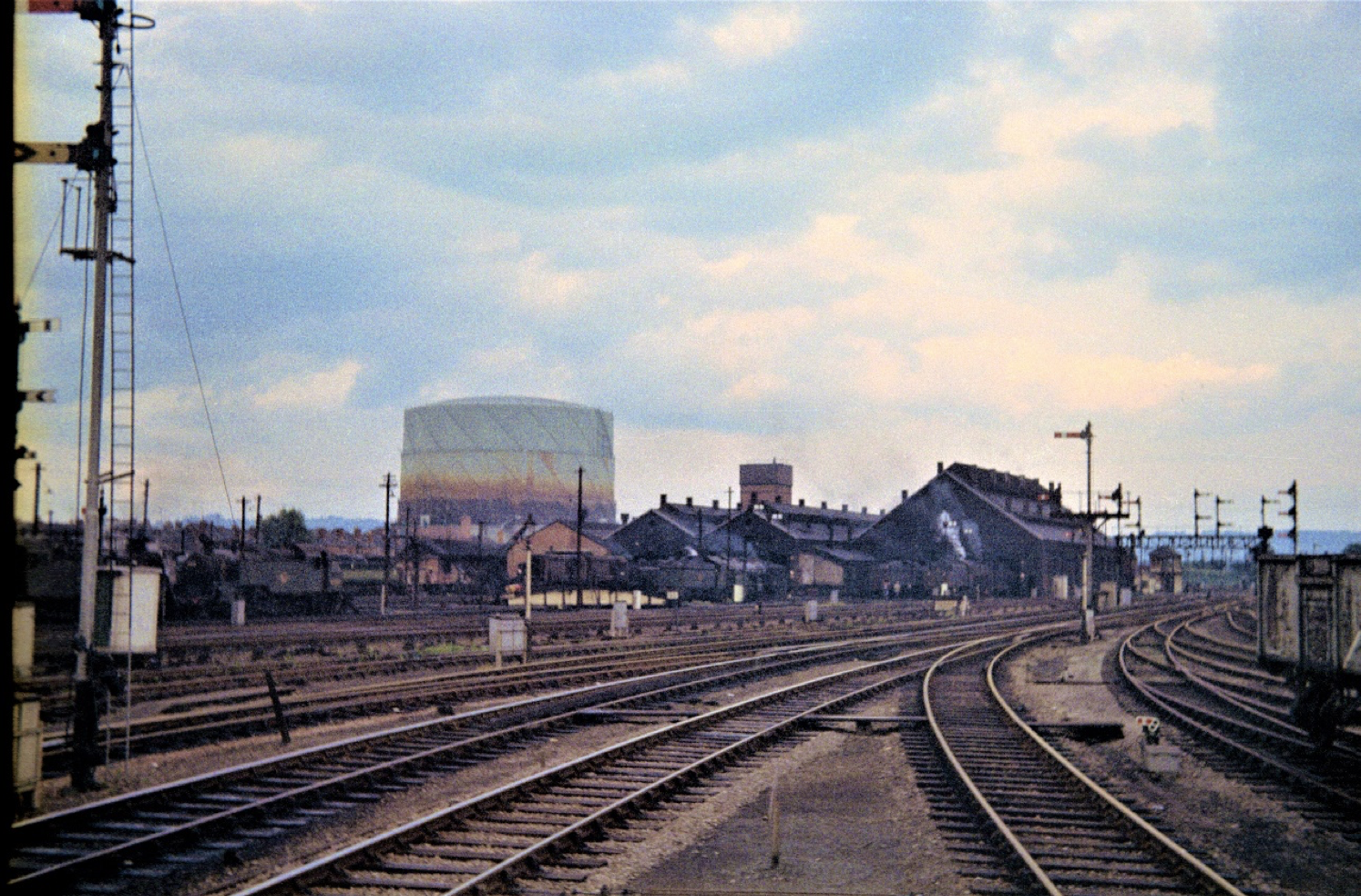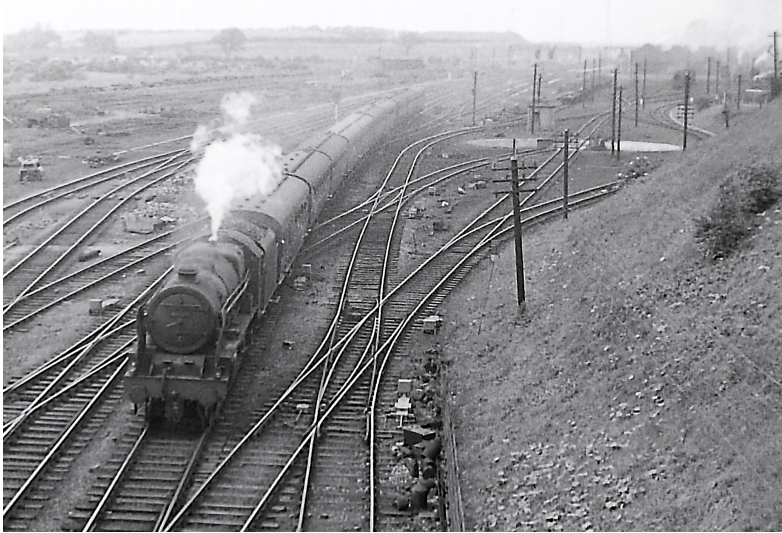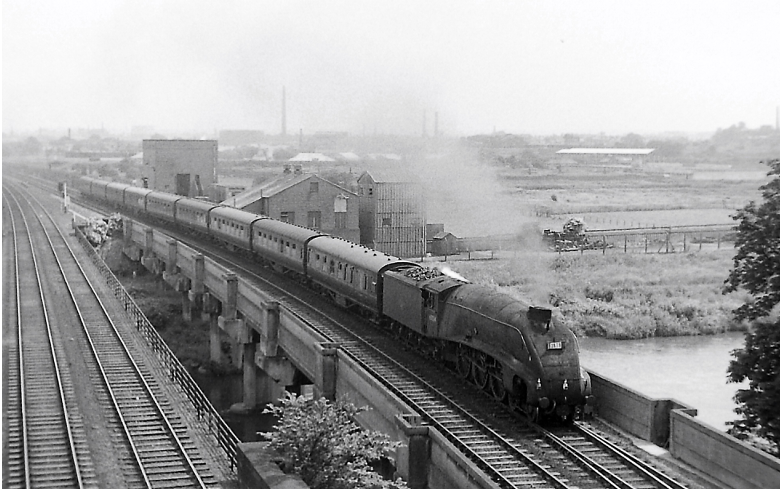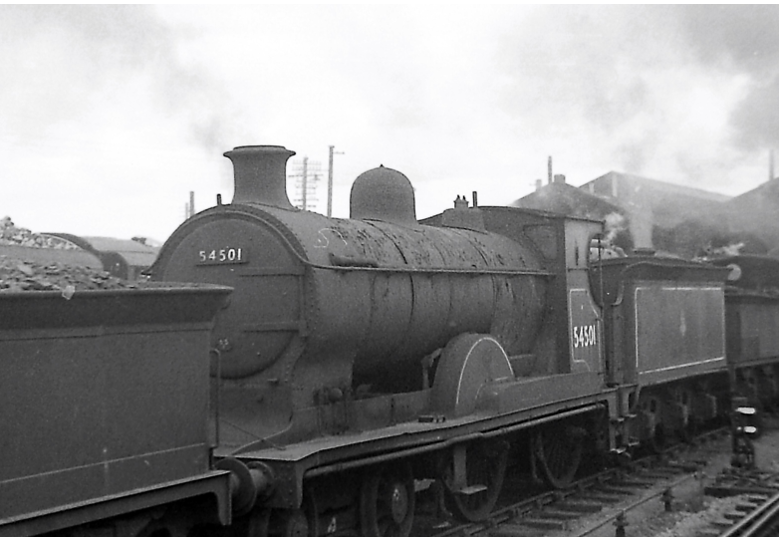Freedom Of Scotland
1963
I had long wanted to visit Scotland. I was much impressed by what I had seen in the railway press, particularly the railway photography of Derek Cross, WJV Anderson and Eric Treacy; records of steam locomotive performance reported by Cecil J Allen; and articles on selected railway routes. This provided the impetus to experience some of these places for myself. Scottish locomotives had turned up occasionally in Gloucester, the most exciting being Corkerhill ‘Jubilees’. Furthermore, a day trip to Carlisle from Blackpool in 1960 had whetted my appetite for Scottish steam, and particularly for some of the older classes such as the LNER ‘D34’ and ‘D49’ classes which until recently had worked over the Waverley route from Hawick.
The ‘Freedom of Scotland’ Railrover provided an excellent way of exploring the network and was good value for money. By 1963 the Highlands had been almost completely taken over by diesels, so my trips there were as much about experiencing the scenery as looking particularly for steam. Nevertheless, there were still pockets of steam around north of Aberdeen and the Cairngorms.
I was now living and working in London, so travelled up to Carlisle by train for my first week of rail-roving in Scotland. On 2 July 1963, I went up to Waterloo from Chessington on the usual 4-SUB, spotting an 8F, No. 48036 on the way at Clapham Junction. From Waterloo I crossed over to Euston to catch the 1.25pm Perth train as far as Carlisle. The train was hauled by a D200 class loco but was not particularly fast as trains were still running to steam schedules that also had copious amounts of recovery time built in for works connected with the electrification to Euston. This becomes obvious when one notes its departure times: 3.09pm from Rugby; 4.48pm from Crewe; 5.56pm from Preston, and 7.40pm from Penrith. However, I did have the pleasure of taking afternoon tea in the first-class Restaurant Car as the train traversed the Trent valley. Two ‘Britannias’ recently transferred to LMR were at Euston (Nos. 70005 John Milton and 70051 Firth of Forth), and No. D1005 Western Venturer was seen at Crewe, having brought in the northbound ‘Pines Express’. Locomotives of this class were still being built at Crewe Works at this time. By now AC electrics were working between Crewe and Manchester. At Warrington Dallam shed (8B) three ex-MR ‘3Fs’, (Nos. 43240/82, 43615) were in store. After spending the night in a noisy B&B on London Road Carlisle (HGVs still passed through the middle of the city on the A6 then as the M6 was not yet built), I rose at dawn for the first part of my journey.
Early on Wednesday 3 July I caught the 7.27am to Glasgow Central. In fact, I nearly missed the train, an overnight sleeper from Euston, as the compartment stock was off the end of the platform by the time I got there. I managed to find a sleeping car door open, and after a quizzing from the attendant (he mellowed once he saw my ‘Freedom of Scotland’ ticket), got shown through to the seating accommodation. Beattock (66D) still had its allocation of Fairburn 2-6-4Ts for banking duty, and the class were also much in evidence on the south Clyde suburban services out of Glasgow Central, including the Cathcart Circle. Passing Carstairs I noticed a 2-10-0 ‘WD’, No. 90768, in store, along with two ex-Caledonian Railway 0-6-0s (Nos. 57604/89); whilst ‘Black 5’ 4-6-0 No. 44956 was on Polmadie shed (66A) sporting an exhibition livery, just ex-works.
After arrival at Central station, I crossed to Buchanan Street to join the 11.15am to Dundee, hauled by No. 44931. It was good to see an ‘A4’, No. 60011 Empire of India, on St Rollox (65B), waiting to work one of the Aberdeen expresses. On approaching Stirling, I noticed that the shed (65J) contained several Caley 0-6-0s in store (including Nos. 57252, 57579). From Stirling I then caught the 1.15pm to Oban, hauled by No. D5354, and travelling by way of Kinghouse Platform, overlooking Loch Voil and Balquidder; Lochearnhead; and climbing up Glen Ogle. The scenery was splendid, but it proved difficult to take photographs from the moving train, so my attempts were not successful. Although the Ballachulish branch was being worked by a DMU, I was pleased to see steam in the form of Standard ‘4’ 2-6-4T No. 80092 in charge of the Killin branch. Otherwise, services in the west Highlands had been taken over by diesels. I stayed in Oban long enough to see McCaig’s Tower before returning to Glasgow. I managed to find a seat in the Observation Car aboard the 5.3pm from Oban. At Crianlarich, I changed from the Lower to the Upper station to connect with the 7.16pm to Glasgow. Standard ‘4’ 2-6-0 No. 76100 was noted at Dumbarton. Cowlairs works at the top of the incline from Queen Street station contained a withdrawn ‘Jubilee’, No. 45713 Renown which was sad to see, but also one of the diminutive ‘J88’ 0-6-0Ts, No. 68345, presumably a works shunter.
I made my base at the YMCA Hostel in Bothwell Street, where bath, bed and breakfast could be obtained for a reasonable fee. The premises were rather austere, and the bathwater was tepid, but I became accustomed to Scottish breakfasts apart from this establishment’s predilection for tinned tomatoes, which I disliked.
On the next day, Thursday 4 July I embarked on a trip farther north boarding ‘The Grampian’ at Buchanan Street (the 8.25am to Perth), hauled by No. 60041 Salmon Trout, one of three ‘A3s’ allocated to 65B at that time. I managed to spot two Caley 4-4-0s in store at 65J and Perth (63A), and on arrival at Perth was surprised to see the Edinburgh – Inverness train arrive behind no less than an ‘A1’ Pacific No. 60159 Bonnie Dundee. I was taking this train, which duly left at 11.04am headed by Nos. D5330 and D5122, but unfortunately, the former failed at Murthly, not long after the start. My first trip across the Grampians was exciting, but more was to come, as I was to take the 5.40pm from Inverness to Kyle of Lochalsh, traversing arguably the most scenic line in Scotland. I took some scenic photos from the train at Garve, around Lochluichart, and of Sgurr na Fintaig, near Achnashellach.
I obtained a room in the palatial Lochalsh Hotel, although I could not take full advantage of its facilities as I had to rise at dawn the next morning. I did take a late evening photo from the Hotel of MV ‘Lochmor’, the Outer Isles mail steamer, and the Kyleakin ferry though. The night porter was very obliging and produced a boiled egg for an early breakfast. Thankfully, I managed to catch the 5.10am steamer to Mallaig to connect with the 7.48am service to Glasgow Queen Street, a journey of over five hours. The only remaining steam locomotive on the West Highland line was ‘4F’ 0-6-0 No. 44255, dead on Fort William shed. I tried to get a photo of the Falls of Monessie, near Roy Bridge, but not very effectively.
After a short break in Glasgow, I took the 2.30pm to Edinburgh Waverley, behind ‘B1’ No. 61221 Sir Alexander Erskine-Hill passing Cowlairs works again and noticing for the first time some ‘V3’ 2-6-2Ts. ‘J37s’ were also in evidence en route to Edinburgh. Several ‘A1’ Pacifics and ‘B1s’ were on show here, but my next connection was soon ready for boarding; the ‘North Briton’, departing at 5.2pm for Berwick-upon-Tweed. On passing St Margaret’s shed (64A), I was surprised to see ‘A2’ Pacific No. 60512 Steady Aim in store along with 2 ‘V2s’ and ex-NB locos, ‘N15’ No. 69128 and ‘J36’ No. 65224 Mons. At Berwick I caught the 6.35pm to St Boswells, pulled by Standard ‘2’ 2-6-0 No.78046, passing Tweedmouth depot (52D) which contained three Ivatt ‘2’ 2-6-0s. My train consisted of one coach and one van, and not more than six passengers at maximum. Nevertheless, it was a beautiful run along the banks of the Tweed through Coldstream as the evening mists settled in the valley. In the fifties this line had been worked by ‘C13s’, ‘D30s’ and ‘V3s’, but certainly was now a branch whose days were numbered.
I had a long wait at St Boswells before the 9.15pm back to Edinburgh Waverley was due. That gave me an opportunity to inspect the ruins of Dryburgh Abbey by the River Tweed. On the way back to Edinburgh, a bonus was the sighting of another ‘A1’ Pacific, No. 60161 North British, at Galashiels working southbound on the Waverley route. Tonight, though, I would have to bed down in the waiting room at Waverley as my next train was not until the early morning of Saturday 6 July, when I was going on to Carlisle to photograph the summer Saturday extras.
So at 5.10am on Saturday morning I caught the first train to Glasgow Queen St (an overnight train from Colchester), and then crossed town to catch the 7.0am stopping train from Glasgow Central behind Standard ‘5’ 4-6-0 No. 73062, noting in store at Carstairs (66E) more withdrawn Caledonian 0-6-0s. On arrival at Carlisle, I made my way by Ribble bus to Etterby Scaur (Ribble’s full-fronted Leyland PD3s were working the town routes then). This was where the lines to the north crossed the river Eden just south of the entrance to Kingmoor depot (12A), and I spent the middle of the day taking photographs of summer Saturday extras. Probably the most surprising aspect of steam working was the use of ‘Black 5s’ on many of these trains, whilst the higher-powered locos, including the Duchesses seemed to be consigned to less demanding duties. But it was also interesting to note that troop trains were still in evidence: the empty stock of a southbound train previously headed by two class 5s, later returned north behind Haymarket (64B) depot’s ‘A4’, No. 60024 Kingfisher.
Photos below:
Top: ‘Royal Scot’ 4-6-0 No. 46155 The Lancer has steam to spare as it slows though Etterby Junction past the entrance to Carlisle Kingmoor Motive Power Depot at the head of the 11.50am Glasgow – Morecombe Promenade on 6 July 1963.
Bottom: ‘A4’ Pacific No. 60024 Kingfisher accelerates out of Carlisle across the River Eden returning north with 3S79, the empty coaching stock of a previous southbound special troop train on 6 July 1963.
I returned north on the diesel-hauled 4.2pm to Edinburgh (the ‘Waverley’). This line had been the haunt of Carlisle Canal (12C) and 64B ‘A3’ Pacifics, and on my first visit to Carlisle in 1960 had seen No. 60100 Spearmint lurking in the bay platform at the head of a six coach semi-fast to Edinburgh Waverley. On this occasion, I was not lucky enough to ride behind one, but saw No. 60098 Spion Kop at Canal shed. At Hawick 2-6-0 No. 78047 was on shed. I completed the day by taking the 7.32pm from Princes Street to Glasgow Central, and noticed 0-4-4T No. 55124, one of Lambie’s ‘19’ class built in 1895, in store on Dalry Road (64C) depot, along with 0-6-0 No. 57550.
Sunday 7 July was a day of rest, as befits the Scottish Presbyterian tradition, and so I decided to take a boat trip to Campbeltown on the Mull of Kintyre, courtesy of the Caledonian Steam Packet Co Ltd steamer, ‘Duchess of Montrose’. I found out subsequently that she was sold for scrap two years later [January 1966 Railway Observer]. The trip afforded good views of Goat Fell, on the Isle of Arran. I caught the 10.50am from Glasgow St Enoch to Fairlie Pier, competently handled by No. 76098, a Standard ‘4’ 2-6-0. En route the depot at Ardrossan (67D) contained on the scrap line an ex-Midland ‘2P’ 4-4-0, No. 40597, along with two Drummond 0-6-0s, Nos. 57348/68. After an afternoon in Campbeltown, I returned on the 7.30pm from Largs to St Enoch, staying again at Glasgow YMCA overnight.
On Monday 8 July, I decided to revisit GSW territory, catching the 10.00am from St Enoch to Ayr and the 12.30pm back to Paisley Gilmour St. These services based on St Enoch were mainly in the hands of Standard (Riddles) 2-6-4Ts. Ayr shed (67C) had a pair of Caley 0-4-4Ts (Nos. 55262/4) awaiting disposal, but Hughes ‘Crabs’ were still much in evidence for use on trip workings in the Ayrshire coalfield. In the afternoon I took the 1.33pm from Paisley to Gourock and 3.20pm back to Glasgow Central, spotting dock shunter 0-6-0T No. 47163 on shed at Greenock (66D). The intensive south Clydeside suburban services based on Central were worked mainly by Fairburn 2-6-4Ts. On returning to Glasgow, the evening was spent on a round trip from Queen Street at 6.0pm via Edinburgh, departing 7.3pm to Perth, where I copped another 64B ‘A3’ Pacific, No. 60099 Call Boy. I returned from Perth at 8.37pm to Buchanan Street behind ‘B1’ 4-6-0 No. 61172.
The next day was prefaced by an overnight trip, this time aboard the 11.15pm from Buchanan Street to Inverness, alighting at Aviemore. Here I caught the 4.20am to Elgin, to travel along the coast of the Moray Firth via Buckie – a scenic delight in the early sun of a summer morning. At Tillynaught Standard 2-6-0 No. 78045 waited with the Banff branch train. Inverurie works had a couple of ‘V3s’ on show as well as the usual LNE-type freight locos. My next connection at Aberdeen was the 9.40am to Edinburgh. Dundee’s pride ‘A2’ Pacific No. 60532 Blue Peter was on display at Tay Bridge MPD (62B), but once across the Tay Bridge into Fife, freight locos became more common; especially ‘J37s’, ‘J38s’ and ‘WDs’ working the Fife coalfield, although a couple of ‘A3’ Pacifics were seen on the approach to Edinburgh.
Ex-Caledonian ‘3P’ 4-4-0 No. 54501 on the scrap line at Stirling shed, taken from a passing train on 9 July 1963.
There was also an opportunity to make a final short trip to Stirling to obtain a photo of No. 54501 on the scrap-line at Stirling depot by taking the 1.33pm from Edinburgh and 3.21pm return to Glasgow, before commencing my journey home. I returned south aboard the 4.20pm from Glasgow St Enoch to Kilmarnock via Paisley Canal. This allowed me to take a last look at Corkerhill (67A) depot, which was always special because very occasionally one of their ‘Jubilees’ reached Gloucester when Holbeck (55A) were short of express motive power. It was sad to see one of them, No. 45677 Beatty still on the scrap-line, despite having been withdrawn the previous October. In addition, ex-Polmadie ‘Scots’ Nos. 46102/4 and ‘Duchess’ No. 46230 were stored there, along with two Midland ‘4F’ 0-6-0s, the expected Caley 0-6-0s, two 0-4-4Ts and a ‘2P’ 4-4-0, No. 40615.
At Kilmarnock I transferred to the 6.17pm to Carlisle. Hurlford’s (67B) scrap line, as well as two Caley 0-6-0s and Stanier ‘3’ 2-6-2T No. 40151, contained five ‘V3’ tanks. These had been made redundant by the North Clydeside electrification but were not appreciated by GSW railwaymen and found little work. Finally, on passing Dumfries depot (68B), it was surprising to see a ‘J72’ 0-6-0T, No. 68750 in the line of stored locomotives alongside ‘2P’ 4-4-0 No. 40672, Caley 0-6-0 No. 57602, and Hughes 2-6-0 No. 42915.
The journey back to England was uneventful, on the 9.23pm departure from Carlisle, although I was joined in my compartment by a man with a Scouse accent and a Scots woman (unrelated), who started by sharing drinks from a suitcase and ended up in a heavy petting session, oblivious of my presence, before they decamped at Crewe. Otherwise I recall little of the journey, although I did record a ‘Duck-eight’, No. 48895, at Wolverhampton.
However, I did time my train back from Birmingham behind ‘Black 5’ 4-6-0 No. 44943 on the 6.18 am Derby – Bristol, which called at Bromsgrove on the way, where surprisingly ‘B1’ 4-6-0 No. 61229 (50A) was present. Bromsgrove was reached in 21 min. 28 sec. from New Street, whilst the 31.1 miles from Bromsgrove to Cheltenham were achieved in 33 min. 43 sec. without speed exceeding 67 mph. Gloucester was reached at 9.10am, in 11min. 41 sec. from Cheltenham.



